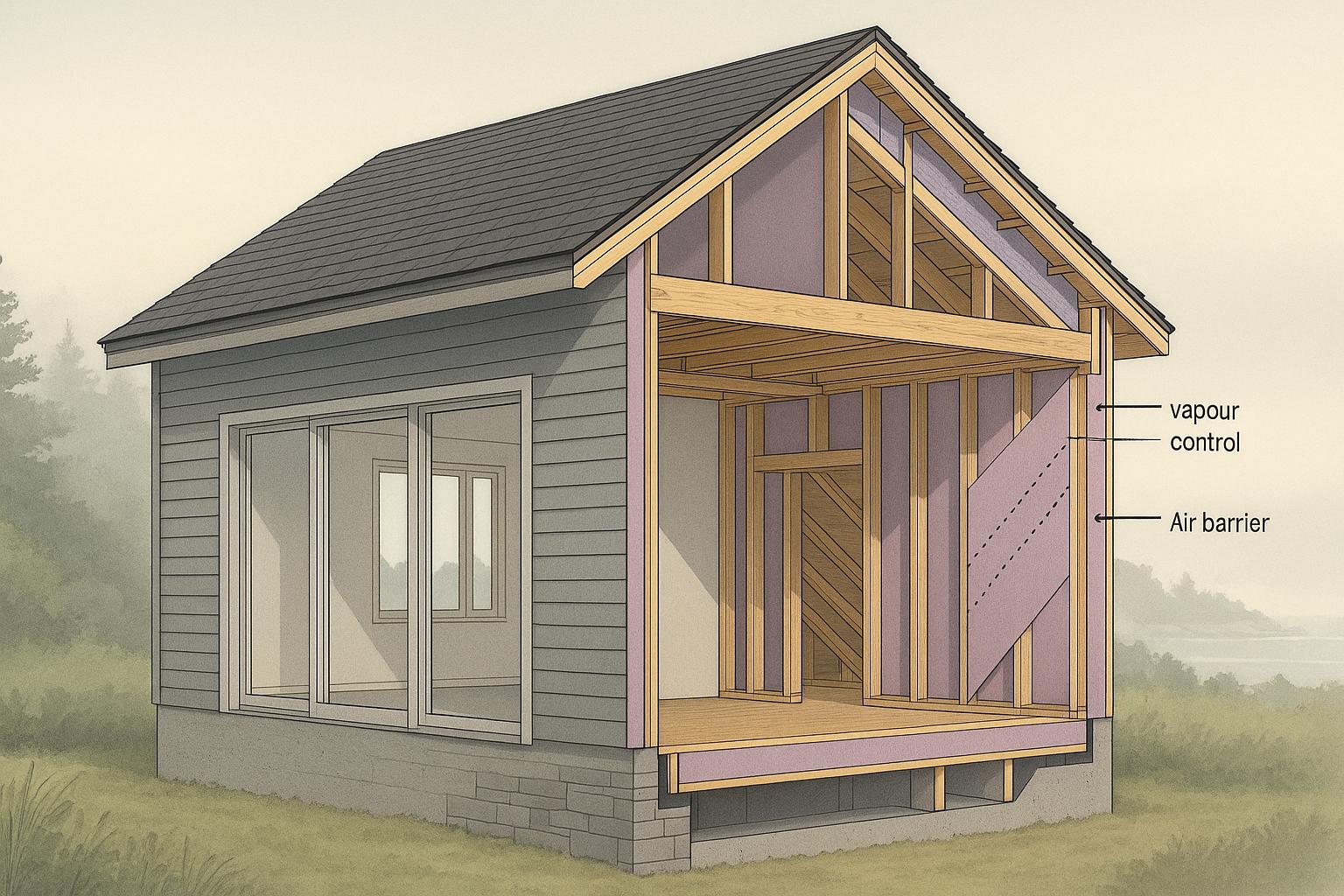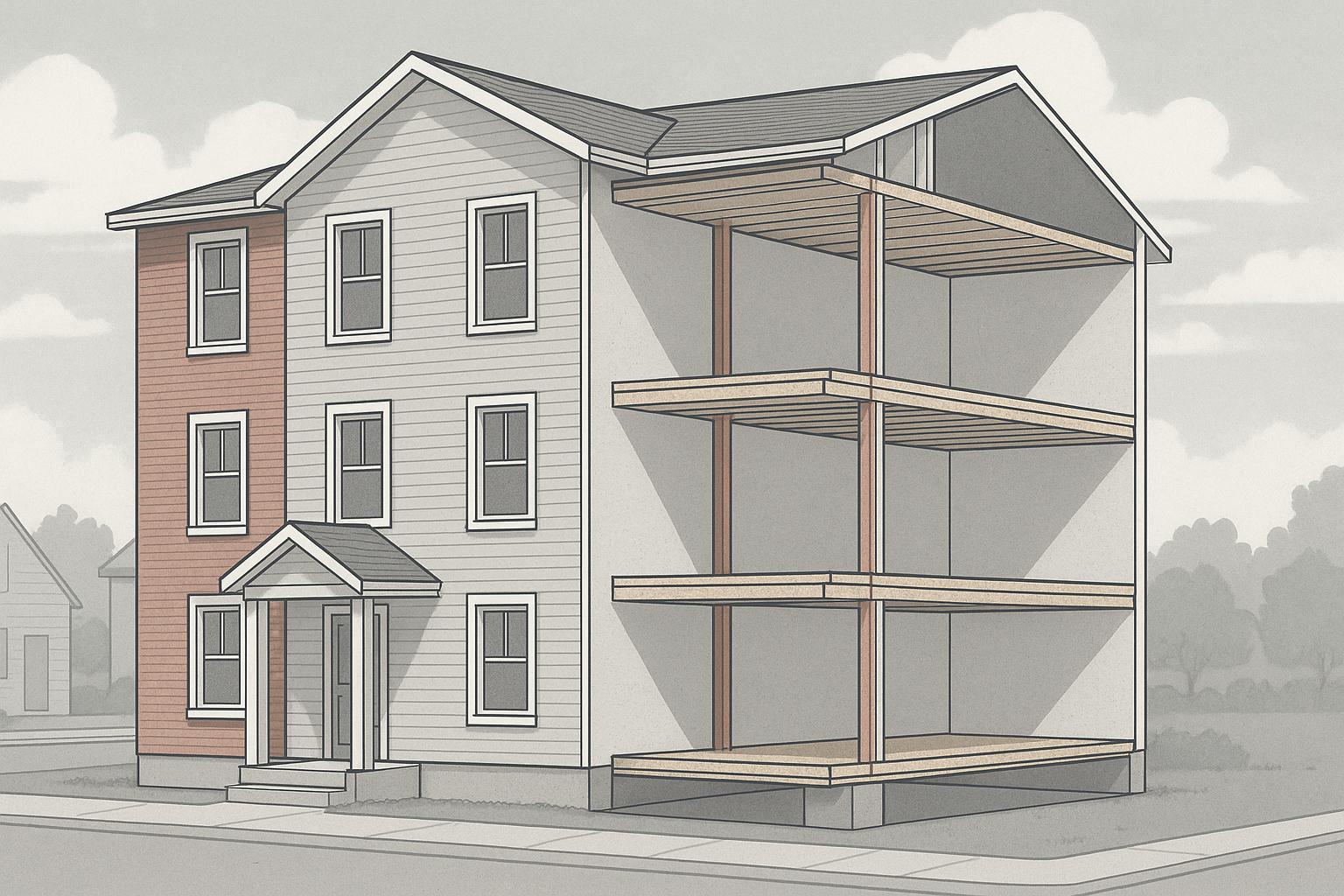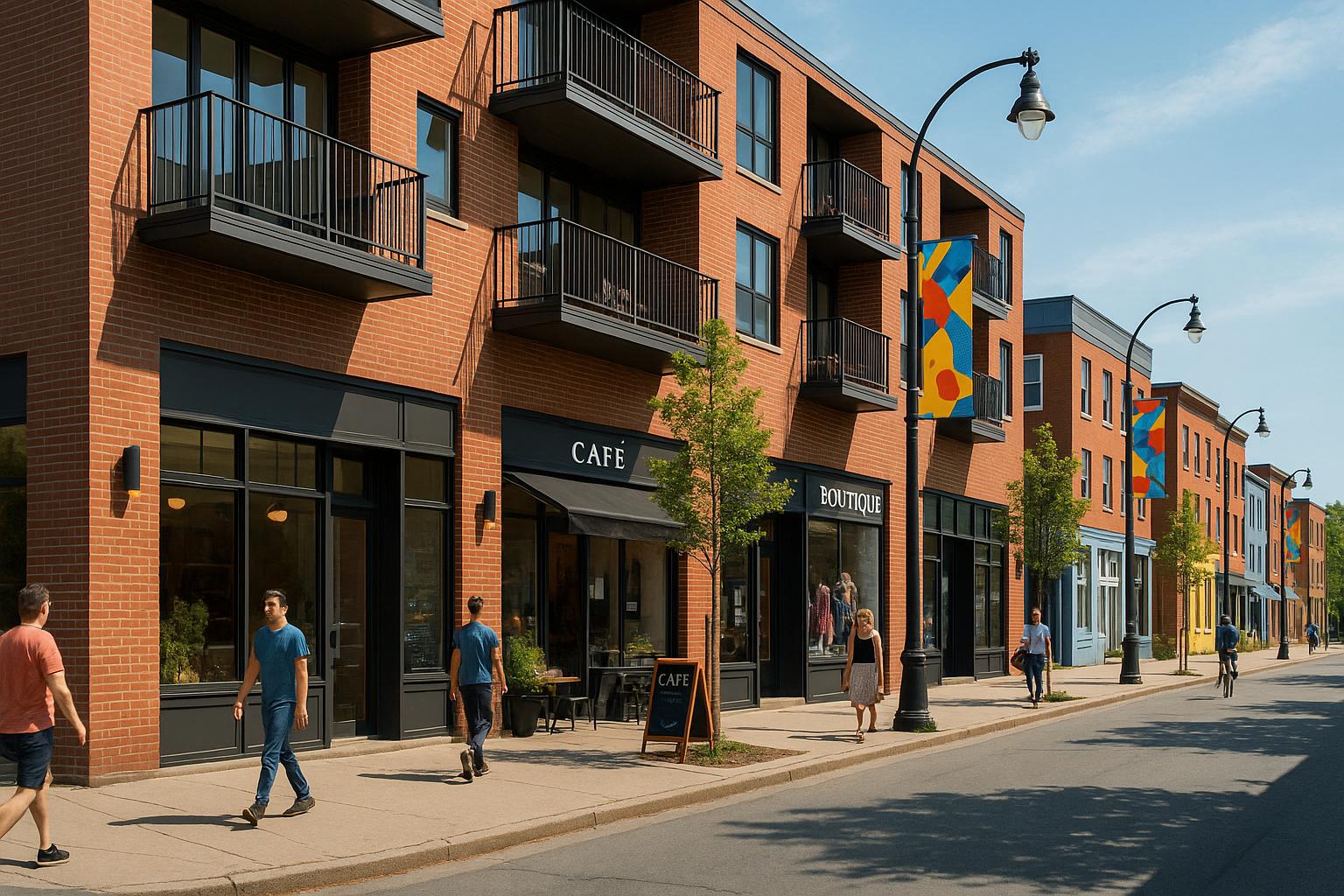Building a rural or off-grid home in Nova Scotia can save you money and offer a peaceful lifestyle. Here’s what you need to know:
- Costs: Nova Scotia’s average house price ($444,067 as of November 2024) is below Canada’s average, making it an affordable option.
- Off-Grid vs Rural:
- Off-Grid: Self-sufficient systems (solar power, wells, septic systems).
- Rural: May access municipal utilities and services.
- Key Systems:
- Power: Solar, wind, or micro-hydro systems (starting at $20,000).
- Water: Private wells ($2,000–$50,000) with regular testing.
- Sewage: Septic systems ($7,000–$25,000).
- Permits: Building, septic, and electrical permits are required. Fees start at $40, with processing times of 2–3 weeks.
- Energy Efficiency: High-quality insulation and passive solar design can reduce energy costs.
Quick Comparison of Off-Grid vs Rural Homes
| Feature | Off-Grid Home | Rural Home |
|---|---|---|
| Power Supply | Self-generated (solar, wind) | May connect to utility grid |
| Water Source | Private well | Municipal water (if available) |
| Sewage | Septic system | Municipal sewage (if available) |
| Location | Remote | Proximity to services varies |
| Independence | Fully self-sufficient | May rely on public utilities |
Building in Nova Scotia offers affordability, natural beauty, and a chance to live sustainably. Plan carefully, secure permits, and design for energy efficiency to make the most of your rural or off-grid property.
Power, Water, and Waste Systems
Power Systems and Setup
Off-grid homes in Nova Scotia often use solar power as their primary energy source. A complete solar setup usually includes solar panels, a charge controller, batteries, and an inverter [1]. To get the most out of your solar panels, position them to face south or southwest, especially to capture winter sunlight.
Wind turbines are another option, particularly in coastal areas or near mountain foothills where wind conditions are steady [1]. If your property has a reliable water source, micro-hydro systems can deliver consistent power generation [1].
Here’s a quick comparison of common power sources:
| Power Source | Best Suited For | Key Considerations |
|---|---|---|
| Solar | Most rural locations | Needs battery storage to handle reduced winter sunlight |
| Wind | Coastal/elevated areas | Requires steady wind patterns |
| Micro-hydro | Properties with water flow | Depends on reliable water availability |
Reliable power is just one piece of the puzzle. Next, let’s look at water systems.
Water Sources and Wells
In Nova Scotia, around 42% of residents depend on private wells, making regular water testing a critical task [2].
"It is estimated that 1 in 5 private well users may have unsafe levels of arsenic in their untreated water" [2].
Testing your water regularly ensures safety and quality. Here’s an idea of the costs:
- Bacteria testing: $30 to $50 (recommended every six months)
- Chemical contaminant testing: $200 to $300 (recommended every two years) [3]
Septic System Requirements
Installing a septic system involves several important steps:
-
System Planning
- Get a professional assessment and design.
- Evaluate soil conditions and property characteristics [4].
-
Approval from Nova Scotia Environment and Climate Change
- Application fee: $66.35
- Processing time: 5–10 business days
- Approval is valid for 3 years [4].
-
System Management
- Follow the On-site Sewage Disposal System Technical Guidelines for installation and maintenance [5].
- Schedule regular inspections.
- Maintain the required minimum distances between wells and septic systems to protect groundwater.
Careful planning and regular maintenance of your septic system are essential for ensuring groundwater safety and a reliable water supply on your rural property.
Land Preparation and Site Work
Access Roads and Driveways
Having reliable access is crucial for both the construction phase and long-term use. If your driveway connects to a public road or is within 100 metres of a highway, you'll need to obtain a Work Within Highway Right-of-Way Permit [6]. Once this is sorted, focus on clearing the site to get the property ready for building.
Site Clearing Guidelines
Preparing the site requires thoughtful planning and adherence to local rules to make sure the property is construction-ready.
Energy-Efficient Home Design
Solar Design and Insulation
Designing an energy-efficient home in Nova Scotia means considering the province's unique climate. Combining passive solar design with high-quality insulation can significantly cut down energy use in rural homes.
Take the Solterre Concept House in Lunenburg, Nova Scotia, as an example. This off-grid, LEED Platinum-certified home uses super-insulation techniques: R-30 for the sub-slab, R-55 for the walls, and R-100 for the roof [8]. These insulation levels help keep the home warm even during the province's harsh winters.
South-facing windows can maximize passive solar energy, while super-insulation ensures consistent indoor temperatures. According to Solterre Design:
"One of the great benefits of the Passive House (Passivhaus) standard is that with the super insulated envelope, the house will never drop below 15 degrees Celsius, even without a heating system" [8].
This combination of solar design and insulation creates a strong foundation for efficient heating and energy storage systems.
Heating and Storage Planning
To complement insulation and solar design, reliable heating and storage systems are essential for year-round comfort. Using both primary and backup heating sources ensures that your home stays comfortable in all seasons. For rural properties, wood stoves are a practical choice, offering independence from the power grid.
"The solar array lets us run anything from our water and sewer pumps to the internet and TV satellite dishes and we only need propane to run our hot water and stove and solely heat the house with a great 'Blaze King' catalytic wood stove."
– Manuela Mueller, Homesteader [7]
Here are some heating options to consider for your rural Nova Scotia home:
| Heating System | Benefits | Cost Efficiency |
|---|---|---|
| Pellet Stove | Automated and efficient heating | $35–$45/month (40 lb bags at $4–$9 each) [9] |
| Catalytic Wood Stove | Grid-independent; uses local fuel | Cost depends on wood source |
| Solar Thermal Panels | Renewable heat with low running costs | Minimal operating costs |
| Geothermal Heat Pump | Reliable in all seasons | Higher upfront cost, but lower operating costs |
Make sure to allocate space for:
- Fuel Storage: Keep enough wood or pellets for winter.
- Battery Banks: Store solar power in ventilated areas.
- Equipment Room: Dedicated space for mechanical systems and backup power.
The effectiveness of off-grid homes in Nova Scotia highlights the advantages of energy-efficient planning. One homeowner shared:
"When we bought our property in Nova Scotia about six years ago, we never intended to be living off the grid, but the $200,000 quote from the power company to get power in, let the idea of 'going solar' become a no brainer" [7].
sbb-itb-16b8a48
Building Permits and Rules
Nova Scotia Building Code Rules
Homes in rural Nova Scotia must follow the provincial Building Code, which incorporates national standards:
| Construction Element | Required Standards |
|---|---|
| Design & Structure | Must align with the National Building Code of Canada |
| Energy Efficiency | Must meet the National Energy Code of Canada for Buildings |
| Plumbing Systems | Must comply with the National Plumbing Code of Canada |
| Farm Buildings | Must follow the National Farm Building Code of Canada |
For accessory buildings smaller than 20 m², a building permit is generally not required unless specified by the municipality [10]. However, you must still ensure compliance with structural standards and secure permits for septic and electrical systems.
Septic and Electric Permits
Obtaining permits for septic and electrical systems is a critical step in any construction project in rural Nova Scotia. These must be in place before construction begins.
Here’s a breakdown of current permit fees in Nova Scotia:
| Permit Type | Base Fee | Additional Charges |
|---|---|---|
| Residential Construction | $40 | $2 per $1,000 of construction value |
| Development (zoned areas) | $40 | - |
| Demolition | $40 | - |
| Permit Renewal | $40 | - |
Processing Times:
- Building permits: about three weeks [12]
- Septic system permits: usually issued within two weeks [11]
- Septic permits are valid for 12 months, with a possible 6-month extension [11]
Important Requirements:
Permits will not be issued unless you have:
- Approval for an on-site sewage disposal system
- An electrical permit from the appropriate authority
- "Minister's Consent For Building and Access to Property" for properties impacting public highways [10]
What to Include in Your Application:
- A detailed description of the work
- Land details (PID or assessment number)
- Complete plans and specifications
- Project valuation
- Contact information for all involved parties [10]
Starting construction without the proper permits will result in fees being doubled [12].
Top 3 Reasons why Homesteading in Nova Scotia may be the right move for you!
Conclusion: Rural Building Checklist
Building a rural or off-grid home in Nova Scotia requires careful preparation. Below is a summary of the key planning stages covered earlier:
| Planning Stage | Key Requirements | Estimated Costs |
|---|---|---|
| Water Supply | Well installation and testing | $2,000–$50,000 for well; $30–$50 for testing |
| Power Systems | Solar installation with batteries | Starting at $20,000 |
| Waste Management | Septic system installation | $7,000–$25,000 |
| Utility Hookups | Power line extension and hookups | $10,000–$30,000 depending on location |
Local support for off-grid systems is growing. Amherst Town Councillor Jason Blanch highlighted this shift in thinking:
"The bottom line is, we have to live differently and I know we can live differently, so I wanted to build this house this way because I think it's the right thing to do and I want people to see that it can be done." [13]
To put things into perspective, the average household in Nova Scotia uses between 700 and 1,400 litres of water daily [14]. Earlier sections provide more detailed advice on setting up power, water, and waste systems.
Budget Planning Tips
- Factor in costs for utility hookups, seasonal maintenance, and development fees.
- Consider the distance to utility connections, as this can affect overall expenses.
- Prepare for seasonal shifts in power availability.
Take time to review these considerations and ensure all local permits are secured before beginning construction [15].
FAQs
What are the key cost and infrastructure differences between building an off-grid home and a rural home in Nova Scotia?
Building an off-grid home in Nova Scotia typically comes with higher costs compared to a rural home connected to the grid. Off-grid homes require self-sufficient systems like solar panels with battery storage, generators, or wind turbines, which can significantly increase upfront expenses. These systems must also be robust enough to handle Nova Scotia’s winters with shorter daylight hours and lower solar gain.
For water, both off-grid and rural homes usually rely on drilled wells, with costs depending on depth and water quality testing. Septic systems are essential for wastewater management, costing approximately $15,000 to $25,000, depending on site conditions and system type. Off-grid setups may also include alternative water solutions like rainwater harvesting, which require freeze protection during winter.
Overall, the cost of going off-grid varies widely depending on the property, systems, and infrastructure needed. However, rural homes connected to the grid generally have lower setup costs, as they can rely on municipal power while still needing private water and septic systems.
How can I ensure my private well water in Nova Scotia is safe to drink, and what are the typical costs for testing?
Ensuring the safety of your private well water in Nova Scotia requires regular testing. It’s recommended to test for bacteria (like total coliform and E. coli) every six months and for chemical contaminants every two years. Testing bottles are available at Nova Scotia Health Authority locations or certified labs.
Bacteria testing typically costs $30–$50, while chemical testing for substances like arsenic, uranium, and alkalinity ranges from $200–$300. If any contaminants exceed Health Canada’s guidelines, you’ll need to take corrective action, such as installing water treatment systems. Regular testing helps protect your health and ensures your water meets safety standards.
What steps and permits are required to install a septic system for a new home in rural Nova Scotia?
Installing a septic system for a new home in rural Nova Scotia involves several steps and requires proper permits to ensure compliance with provincial regulations. Here’s what you need to know:
- Site Evaluation and Percolation Test: Before installation, a certified professional must conduct a site evaluation and percolation test to determine the soil's ability to absorb wastewater. This step is crucial for designing the right septic system for your property.
- Approval from Nova Scotia Environment: You’ll need to submit an application to Nova Scotia Environment for approval. This includes providing details about your site, the proposed septic system design, and results from the site evaluation.
- System Installation: Once approved, a licensed installer must complete the installation of your septic system. Options include conventional systems or alternative technologies like peat moss biofilters, depending on site conditions.
- Inspection and Final Approval: After installation, the system must be inspected by Nova Scotia Environment to ensure it meets all regulatory requirements before it can be used.
Costs typically range from $15,000 to $25,000, depending on the system type and site conditions. Early planning is key, as septic systems are essential for rural properties without municipal wastewater services.



